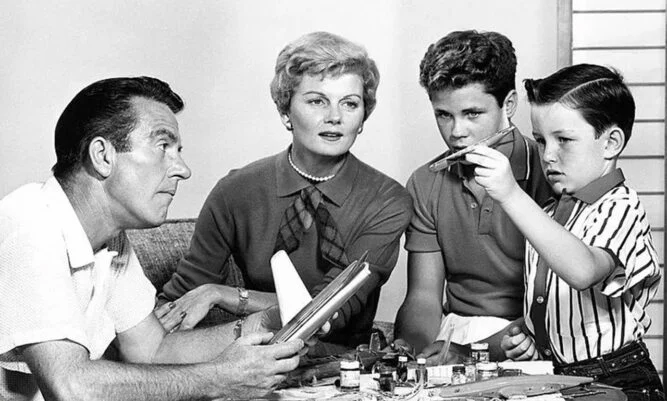This scene wasnt edited, now take a closer look and try not to gasp when you see the unexpected
Leave It to Beaver remains one of the most iconic television sitcoms of all time. Though it first aired decades ago, nearly everyone recognizes its name—even those who have never watched a single episode. But its lasting impact isn’t just because it was a flawless masterpiece. In fact, the show had its share of on-screen blunders, behind-the-scenes quirks, and unexpected historical milestones.
A defining feature of Leave It to Beaver was its portrayal of family life, setting a standard for wholesomeness that few shows have matched. From 1957 to 1963, it delivered humor that was both innocent and timeless, and even today, viewers still find its stories relatable and amusing. But what makes the show even more intriguing are the little details that slipped through the cracks—details that make watching it now even more enjoyable.
Take, for example, the kitchen calendar in June Cleaver’s home. Though the rest of the set was always pristine, the calendar was sometimes outdated. In The Poor Loser episode from 1963, it was still stuck on 1961. And if you look closely at the baseball game tickets in that same episode, you’ll notice “Mayfield” is misspelled as “Mayfied.”
One of the strangest production mishaps happened in The Silent Treatment. When Beaver paints a door, a bee starts buzzing around his face—but if you look carefully, you can actually see the string keeping the “bee” in place, bouncing along with it.
At the heart of the show was Jerry Mathers, who played Theodore “Beaver” Cleaver. Now 76 years old, he still gets asked if he was anything like his character. His answer? “Well, I got into a lot less trouble.” He reminisced about the set being like a big family, where the cast and crew looked out for him and made sure he enjoyed his time there. When he auditioned for the role, he wasn’t even thinking about Hollywood—he was just eager to get to his Cub Scouts meeting. That honesty and innocence won over the producers, sealing his place in TV history.
Wally Cleaver, played by Tony Dow, was another beloved character. He was more than just the “older brother”—he captured the universal struggles of adolescence, making him one of television’s most relatable figures. Initially, Paul Sullivan was cast in the role, but a sudden growth spurt made him look too old, and Dow stepped in to fill the part. His portrayal was so natural and heartfelt that even today, Wally Cleaver is remembered as the perfect big brother.
June Cleaver, played by Barbara Billingsley, was the epitome of the classic 1950s mother—graceful, poised, and always composed. But what many don’t know is that her signature pearl necklace wasn’t just a fashion statement. She wore it to hide a surgical scar on her neck. As her on-screen sons grew taller, she also started wearing high heels more often to maintain a sense of authority.
One of the show’s most touching aspects was the real-life friendship between Jerry Mathers and Tony Dow. Their bond extended far beyond the screen. In a 2006 interview, Mathers described Dow as the “perfect big brother,” admiring his athleticism, intelligence, and kindness. When Dow passed away in 2022, Mathers shared his grief, saying, “He was not only my brother on television. Tony leaves a void in my heart that will never be filled.”
Leave It to Beaver also broke barriers in ways many people don’t realize. In one episode, Wally is shown carrying a toilet seat—a shocking moment for 1950s television. At the time, even acknowledging a bathroom’s existence was considered inappropriate, making this a small but significant step forward in TV history.
One of the show’s most unique creative decisions was its approach to humor. Unlike many sitcoms that relied on exaggerated gags, Leave It to Beaver wanted its comedy to feel natural. The creators even had a rule—if a joke got too big of a laugh, they’d cut it. They wanted the warmth of the characters and their interactions to be the heart of the humor, not forced punchlines.
Decades later, Leave It to Beaver remains a beloved piece of television history, cherished for its charm, authenticity, and the simple, heartfelt lessons it brought into American homes. Hidden mistakes, behind-the-scenes stories, and groundbreaking moments only add to its legacy, proving that sometimes, imperfection makes something even more unforgettable.




